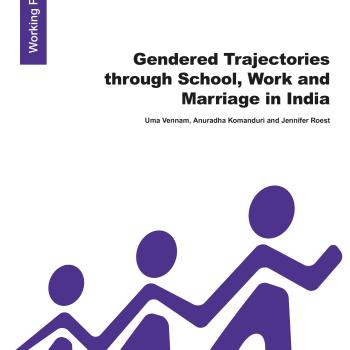
This working paper examines how gender affects girls’ and boys’ school, work and marriage trajectories across adolescence and into early adulthood in Andhra Pradesh and Telangana in India. It explores when gender inequality begins to open up in childhood; in which domains, how and why gender disparities persist across adolescence and into early adulthood; and, finally, whether and how gendered norms, values and practices impact on children’s trajectories.
Based on analysis of qualitative longitudinal data, gathered from children and their parents, and descriptive survey statistics, we find that:
early disadvantages resulting from poverty, debt, the illness of a family member or a death in the family, play a key role in framing young people’s trajectories, as do gender norms that influence the different roles, responsibilities, opportunities and social risks that girls and boys are exposed to; poverty emerged as a key influencing factor, often irrespective of gender, on young people’s trajectories; it was where families were most financially insecure that gender norms became most salient and differences between girls’ and boys’ trajectories most distinct; though gender roles can be set from a young age, it was not until adolescence that the most substantial differences began to appear, with poorer girls more likely to leave school early and transition to marriage, while boys became increasingly responsible for providing financially for their families.
The data presented in this paper suggest that gendered differences in girls’ and boys’ trajectories through education, work and marriage still exist despite the implementation of a number of government programmes and efforts to address gaps, with differences emerging most conspicuously at the point at which poverty and gendered social norms intersect.

This working paper examines how gender affects girls’ and boys’ school, work and marriage trajectories across adolescence and into early adulthood in Andhra Pradesh and Telangana in India. It explores when gender inequality begins to open up in childhood; in which domains, how and why gender disparities persist across adolescence and into early adulthood; and, finally, whether and how gendered norms, values and practices impact on children’s trajectories.
Based on analysis of qualitative longitudinal data, gathered from children and their parents, and descriptive survey statistics, we find that:
early disadvantages resulting from poverty, debt, the illness of a family member or a death in the family, play a key role in framing young people’s trajectories, as do gender norms that influence the different roles, responsibilities, opportunities and social risks that girls and boys are exposed to; poverty emerged as a key influencing factor, often irrespective of gender, on young people’s trajectories; it was where families were most financially insecure that gender norms became most salient and differences between girls’ and boys’ trajectories most distinct; though gender roles can be set from a young age, it was not until adolescence that the most substantial differences began to appear, with poorer girls more likely to leave school early and transition to marriage, while boys became increasingly responsible for providing financially for their families.
The data presented in this paper suggest that gendered differences in girls’ and boys’ trajectories through education, work and marriage still exist despite the implementation of a number of government programmes and efforts to address gaps, with differences emerging most conspicuously at the point at which poverty and gendered social norms intersect.

